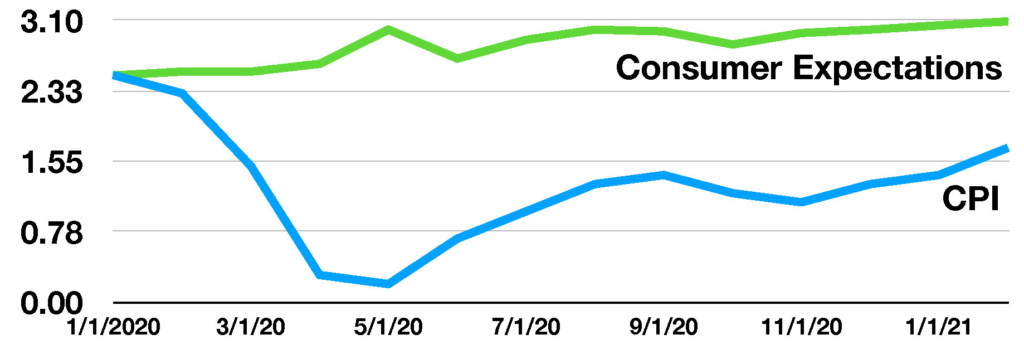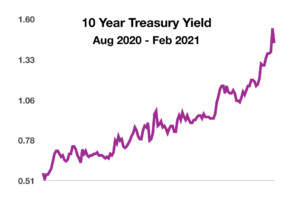
Joseph Schw
Stephen Dygos, CFP® 612.355.4364
Benjamin Wheeler, CFP® 612.355.4363
Paul Wilson 612.355.4366
www.sdwia.com
Stock Indices:
| Dow Jones | 44,094 |
| S&P 500 | 6,204 |
| Nasdaq | 20,369 |
Bond Sector Yields:
| 2 Yr Treasury | 3.72% |
| 10 Yr Treasury | 4.24% |
| 10 Yr Municipal | 3.21% |
| High Yield | 6.80% |
YTD Market Returns:
| Dow Jones | 3.64% |
| S&P 500 | 5.50% |
| Nasdaq | 5.48% |
| MSCI-EAFE | 17.37% |
| MSCI-Europe | 20.67% |
| MSCI-Pacific | 11.15% |
| MSCI-Emg Mkt | 13.70% |
| US Agg Bond | 4.02% |
| US Corp Bond | 4.17% |
| US Gov’t Bond | 3.95% |
Commodity Prices:
| Gold | 3,319 |
| Silver | 36.32 |
| Oil (WTI) | 64.98 |
Currencies:
| Dollar / Euro | 1.17 |
| Dollar / Pound | 1.37 |
| Yen / Dollar | 144.61 |
| Canadian /Dollar | 0.73 |
Macro Overview
The prospect of resurgent inflation has developed into a growing concern for markets globally. Some believe that current inflationary pressures may be transitory and not lasting, while others contend that higher prices may become more permanent.
Rising fiscal deficits along with increasing levels of federal debt are prompting the administration to explore the most significant tax hikes since 1993. Tax increases are being considered for corporations, businesses structured as pass-through entities, estate taxes, and capital gains.
Optimism surrounding a third round of stimulus payments along with rising vaccination rates fueled equity markets in March as an economic revitalization began to take hold. Major equity indices ended the quarter positively as companies saw a resurgence in activity and sales.
The pandemic has brought about modifications and changes to business models throughout numerous industries, many of which are passing along higher costs to consumers. Many of the higher cost trends are not being recognized by some government inflation gauges and not accounted for in forecasts. The suggestion that inflationary pressures are only temporary are being contested as a growing number of businesses are expected to make pricing changes permanent.
The IRS announced that it is extending the tax filing deadline to May 17th, allowing tax payers more time to assess the effects of COVID related changes for individual and small business filers. With the IRS extending the deadline, nearly all states will follow suit and extend the tax deadline to May 17th as well, but most are maintaining the due date of April 15th for estimated tax payments.
In addition to stimulus payments, the $1.9 trillion bill passed in March, known as the American Rescue Plan Act of 2021, will provide an exemption on taxes paid on unemployment benefits up to $10,200. The IRS communicated that automatic refunds would be issued to those who have already filed their 2020 taxes and have paid taxes on unemployment last year.
A $2.25 trillion infrastructure plan introduced by the administration is expected to focus on transportation, cleaner water, high-speed broadband and manufacturing. An increase in corporate taxes is the primary source of funding the proposed plan.
Many economists believe that the third stimulus aid package may be excessive and inflationary, simultaneously being issued as economic activity is reigniting in parts of the country. Thus far, the total amount of the three stimulus bills combined since the pandemic began is over $5 trillion.
The rapid rise in mortgage rates since the beginning of the year has led to a slowdown on refinances nationwide. The 30-year fixed rate mortgage reached the highest level in over nine months at 3.17% as of March 25th, yet still at historical lows relative to the 50-year average for a 30-year fixed mortgage rate of 7.88%.
Identified mutations of the COVID-19 virus have raised concerns about the spread of a variant known to be more transmissible than the initial virus, prompting the CDC to caution the public about relaxing preventive measures.
Sources: IRS, Federal Reserve, CDC, Congress.
Yields Continue To Move Upward – Fixed Income Update
Yields rose across all fixed income sectors, with the 10-year Treasury yield reaching 1.74% as of March 31st, the highest level since January 2020. The onslaught of rising yields has been in conjunction with heightened inflationary pressures.
Some analysts and economists believe that interest rates will rise more slowly in response to inflation, allowing for gradually elevating bond yields. Higher bond yields have historically led to higher loan rates from mortgages to credit cards.
Sources: U.S. Treasury, Bloomberg
Markets Gained On Optimism – Equity Overview
Optimism deriving from continuing fiscal and monetary stimulus efforts in addition to vaccination progress, drove equites higher in the first quarter. Major equity indices moved higher with the energy, financial and industrial sectors leading in the first quarter.
International developed market indices were mostly positive for the first quarter, with emerging market indices primarily flat to negative amid growing debt concerns. Rising inflation is stoking some hesitation among debt heavy global companies as costs to operate and borrow increase.
As the cost of production materials has increased over the past few months, so has the concern as to how company earnings will be affected. The PPI Index, which measures wholesale production prices for companies has been rising steadily for the past year.
Sources: BEA, Bloomberg, Federal Reserve
How Government Inflation Gauges Differ – Macro Economic Dynamics
The traditional gauge for inflation, known as the Consumer Price Index (CPI), is being challenged by yet another government produced measure known as Consumer Expectations. The most recent data released shows an inflation rate of 1.7%, as noted by the CPI compiled by the Bureau of Economic Analysis for February 2021. The Federal Reserve maintains its own inflation gauge, yet is based on consumer expectations of where inflation is headed. That inflation gauge ended February at 3.09%.
Many economists believe the Fed’s inflation gauge to be a more accurate indicator of actual inflation since it is directly based on consumer expectations. The traditional CPI extracts food and energy, ironically two of the most inflationary areas for consumers this past year.
Some of the items included in the CPI basket are housing, clothing, transportation, medical care, and education. The challenge of the CPI is that it takes a look-back approach rather than a look-forward approach which takes consumer expectations into account. Expectations also vary among age groups, where seniors are more concerned about medical care and transportation, while younger adults worry about apparel and housing.
Sources: BEA, Federal Reserve
Stimulus Bill Provisions For Individuals – American Rescue Plan Act of 2021
Economic Impact Payment (EIP) of $1400 per individual with an Adjusted Gross Income (AGI) of up to $75,000 based on 2019 tax returns or 2020 returns if already filed.
EIPs for qualifying dependents over 16 years of age based on parent’s income.
Up to $10,200 of unemployment compensation exempted from federal income taxes for tax year 2020 for taxpayers earning less than $150,000 AGI. Married couples can exclude up to $20,400 of unemployment benefits if both spouses received unemployment in 2020.
Federal unemployment benefit payments of $300 per week have been extended through September 6, 2021.
Child Tax Credit of $3000 per qualifying child under 18 years of age, subject to phaseout thresholds starting at $75,000 AGI for singles and $150,000 for married couples.
Recovery Rebate Credit available to taxpayers that didn’t receive a stimulus payment even though they were eligible. Eligibility for the tax credit is the same as eligibility for the stimulus payments.
Credits for Paid Sick & Family Leave provides eligible self-employed individuals with a credit equal to 100% of the qualified family leave equivalent amount.
Sources: IRS; IRS Coronavirus Tax Relief, Treasury.gov
Where Anticipated Tax Hikes May Hit – Tax Planning
While the three stimulus programs amount to over $4.5 trillion were mostly funded by government debt, the recently introduced $2.25 trillion infrastructure plan will be primarily funded by tax increases. Preliminary indications are that the anticipated tax hikes will target both corporations and high earning individuals. The tax increases may be the largest since 1993. The following are among the proposals currently being considered:
Raising the corporate tax rate to 28% from 21%;
Reducing tax preferences for pass-through entities, such as LLCs, S-Corps & Partnerships;
Tax increases for individuals earning more than $400,000;
Expanding estate taxes;
Higher capital gains tax rate for individuals earning $1 million or more.
The lingering concern is that individual tax payers that are small business owners may end up paying higher taxes even if their incomes are below $400,000. This could occur if the existing 20% pass-through tax deduction is eliminated or altered, essentially affecting about 95% of all businesses in the United States.
Sources: Taxpolicycenter.org
Loans May Be Easier To Qualify For As Mortgage Rates Rise – Housing Market Review
Rising mortgage rates since the beginning of the year have slowed mortgage applications down. Should employment conditions improve allowing more to qualify for loans, then there could be a resurgence in refis and purchases for those that didn’t qualify last year. In addition, some lenders are expected to relax standards as volume declines, easing the loan qualification process. Optimistically, rates are still historically low relative to the 50-year average for 30-year fixed mortgage loans of 7.88%.
Fannie Mae is forecasting that mortgage companies are projected to originate 13% fewer home loans than last years’ record of $4.5 trillion in loans. Both refi and purchase volume are forecast to drop this year.
Even though rates have been rising, many homeowners may still benefit from a refinanced loan since rates are still well below their 50-year average. In addition, limited housing inventory has brought about demand for new construction in various parts of the country, creating new home purchase loans. New home construction, as measured by Housing Starts data tracked by the Federal Reserve, show that new home construction has started to rebound from the lows of the pandemic, ensuing in new home loans.


